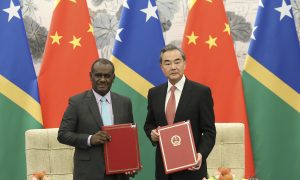Robert Reich: The Democrat’s Disease – OpEd
By Robert Reich
Much of today’s Republican Party is treacherous and treasonous. So why are Democrats facing midterm elections that, according to most political observers, they’re likely to lose? Having been a loyal Democrat for some seventy years (my father liked Ike but my mother and I were for Adlai), including a stint as a cabinet secretary, it pains me to say this, but the Democratic Party has lost its way.
How? Some commentators think Democrats have moved too far to the left — too far from the so-called “center.” This is utter rubbish. Where’s the center between democracy and authoritarianism and why would Democrats want to be there? Others think Biden hasn’t been sufficiently angry or outraged. Please. What good would that do? And after four years of Trump, why would anyone want more anger and outrage?
The biggest failure of the Democratic Party — a disease that threatens the very life of the party — has been its loss of the American working class. As Democratic pollster Stanley Greenberg concluded after the 2016 election, “Democrats don’t have a ‘white working-class’ problem. They have a ‘working class problem’ which progressives have been reluctant to address honestly or boldly. The fact is that Democrats have lost support with all working-class voters across the electorate.”
The working class used to be the bedrock of the Democratic Party. What happened?
Before Trump’s election, Democrats had occupied the White House for 16 of 24 years. Democrats controlled both houses of Congress during the first two years of the Clinton, Obama, and Biden administrations. During those years, Democrats scored some important victories for working families: the Affordable Care Act, an expanded Earned Income Tax Credit, and the Family and Medical Leave Act, for example. I take pride in being part of a Democratic administration during that time.
But I’d be lying to you if I didn’t also share my anger and frustration from those years — battles inside the White House with Wall Street Democrats and battles with corporate Democrats in Congress, all refusing to do more for the working class, all failing to see (or quietly encouraging) the rise of authoritarianism if the middle class continued to shrink. (I offer the following video clip not in the spirit of “I told you so” but as a way of sharing my frustrations and fears at the time.)
The tragic reality is that even when they’ve been in charge, Democrats have not altered the vicious cycle that has shifted wealth and power to the top, rigging the economy for the affluent and undermining the working class.
Clinton used his political capital to pass free trade agreements, without providing millions of blue-collar workers who consequently lost their jobs the means of getting new ones that paid at least as well. His North American Free Trade Agreement and plan for China to join the World Trade Organization undermined the wages and economic security of manufacturing workers across America, hollowing out vast swaths of the Rust Belt.
Clinton also deregulated Wall Street. This indirectly led to the financial crisis of 2008 — in which Obama bailed out the biggest banks and bankers but did nothing for homeowners, many of whom owed more on their homes than their homes were worth. Obama didn’t demand as a condition for being bailed out that the banks refrain from foreclosing on underwater homeowners. Nor did Obama demand an overhaul of the banking system. Instead, he allowed Wall Street to water down attempts at re-regulation.
Both Clinton and Obama stood by as corporations hammered trade unions, the backbone of the working class. They failed to reform labor laws to allow workers to form unions with a simple up-or-down majority vote, or even to impose meaningful penalties on companies that violated labor protections. Biden has supported labor law reform but hasn’t fought for it, leaving the Protecting the Right to Organize (PRO) Act to die inside the ill-fated Build Back Better Act.
At the same time, Clinton and Obama allowed antitrust enforcement to ossify, enabling large corporations to grow far larger and major industries to become more concentrated. Biden is trying to revive antitrust enforcement but hasn’t made it a centerpiece of his administration.
Both Clinton and Obama depended on big money from corporations and the wealthy. Both turned their backs on campaign finance reform. In 2008, Obama was the first presidential nominee since Richard Nixon to reject public financing in his primary and general election campaigns, and he never followed up on his re-election promise to pursue a constitutional amendment to overturn Citizens United vs FEC, the 2010 Supreme Court opinion opening the floodgates to big money in politics.
Throughout these years, Democrats drank from the same campaign funding trough as the Republicans – big corporations, Wall Street, and the very wealthy. “Business has to deal with us whether they like it or not, because we’re the majority,” crowed Democratic representative Tony Coelho, head of the Democratic Congressional Campaign Committee in the 1980s when Democrats assumed they’d continue to run the House for years. Coelho’s Democrats soon achieved a rough parity with Republicans in contributions from corporate and Wall Street campaign coffers, but the deal proved a Faustian bargain. Democrats became financially dependent on big corporations and the Street.
By the 2016 election, the richest 100th of 1 percent of Americans – 24,949 extraordinarily wealthy people – accounted for a record-breaking 40 percent of all campaign contributions. That same year, corporations flooded the presidential, Senate and House elections with $3.4 billion in donations. Labor unions no longer provided any countervailing power, contributing only $213 million – one union dollar for every 16 corporate dollars.
**
Joe Biden has tried to regain the trust of the working class, but Democratic lawmakers (most obviously and conspicuously, Senators Joe Manchin and Kyrsten Sinema) have blocked measures that would have lowered the costs of childcare, eldercare, prescription drugs, healthcare, and education. They’ve blocked raising the minimum wage and paid family leave. They’ve blocked labor law reforms. Yet neither Manchin nor Sinema nor any other Democrat who has failed to support Biden’s agenda has suffered any consequences. Why does Manchin still hold leadership positions in the Senate? Why is Manchin’s West Virginia benefitting from the discretionary funds doled out by the administration?
Why hasn’t Biden done more to rally the working class and build a coalition to grab back power from the emerging oligarchy? Presumably for the same reasons Clinton and Obama didn’t: The Democratic Party still prioritizes the votes of the “suburban swing voter” – so-called “soccer moms” in the 1990s and affluent politically independent professionals in the 2000s – who supposedly determine electoral outcomes. And, as noted, the party depends on big money for its campaigns. Hence, it has turned it back on the working class.
The most powerful force in American politics today is anti-establishment fury at a rigged system. There is no longer a left or right. There is no longer a moderate “center.” The real choice is either Republican authoritarian populism (see here, here, and here) or Democratic progressive populism. Democrats cannot defeat authoritarian populism without an agenda of radical democratic reform — an anti-establishment movement. Democrats must stand squarely on the side of democracy against oligarchy. They must form a unified coalition of people of all races, genders, and classes to unrig the system. Trumpism is not the cause of our divided nation. It is the symptom of a rigged system that was already dividing us.


